(6/29/16) Still learning...
Archives
- December 2017 (1)
- September 2017 (1)
- July 2017 (1)
- June 2017 (20)
- May 2017 (2)
- January 2016 (1)
- December 2015 (1)
- November 2015 (4)
- September 2015 (1)
- August 2015 (1)
Imagine Shepherdess Jen, sitting down with her morning cup of coffee, thinking about what to tell you all about this time...a heavy sigh emits from deep within...she takes another drink of coffee...
Have you ever had days where you feel like you ROCK...where you make the right decisions...where everything you touch turns to gold? Yeah, that's not what I'll be writing about today.
Instead, have you ever had times when you feel like everything you touch turns to garbage? Where you can look back and plot the poor decisions you've made, then draw a line connecting all of those little dots of doom, until your finished product looks like a child's dot-to-dot puzzle gone really wrong?
Yeah, that's what I'll be writing about today.
1. Rotational Grazing
When you have a flock of grazing animals, it's very important that you pay attention to the pasture to make sure that it's not being grazed down too far. A good rule of thumb is to let them into the pasture when the grasses are 6-8" high, then let them graze it down until it's no shorter than 2-1/2", then move them to another section of pasture, allowing the previous section to grow back. I knew this - I learned last year that they will graze down a pasture very quickly, so I needed to be ready to move them into new pastures (which meant making sure we had adequate shade shelters for these other pastures as there are no shade trees in them). I had a plan - I swear, I had a plan!
But you see, last fall, we allowed them to become yard sheep. And we continued to allow them to be yard sheep...all winter long and into the spring, they were yard sheep. Even when their beautiful, lush pasture (that they originally started in last spring and grazed down) was ready for grazing, what did I do? Allowed them to be yard sheep. Which means their beautiful, lush pasture didn't get grazed, and I didn't realize until it was too late that it is now shot for the year - it's totally gone to seed and the sheep won't eat it.
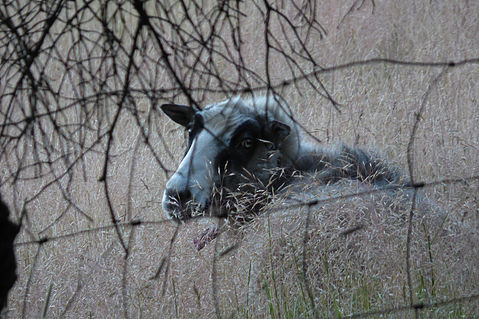
We've tried making them stay in their pasture, but they won't graze. Now, please understand - I know they're spoiled. And perhaps they will eat it if I make them stay in there - but sheep know, for the most part, what's good for them - what tastes right - what they need to be eating. And if they're not eating this, there's a reason - all of the taste, the nutritional value, everything good about it, is gone for the year.
The upside to this is that I learned a very valuable lesson - my sheep are not pets, they are livestock. I know this is shocking to read, and please don't tell the sheep - but I have to stop treating them like dogs in the backyard. It doesn't change how much I love and adore them - it merely changes how I have to interact with and care for them.
2. The Perils of Yard Sheep
As I've previously noted, having yard sheep doesn't work well. It means they want to eat the bushes, tree branches, and all of the yummy variety of things in the yard as opposed to their pasture. It means that some of them get it into their woolly heads that they are King of the Yard (I won't name names...but he's a wether...that's all I'll say) and can treat their owners like the help. And it means that if you happen to have a set of concrete steps leading down to a concrete patio that the sheep really love clip-clopping up and down, accidents can happen...and Mikey got hurt pretty badly on these steps. Imagine falling down a set of concrete steps with your hands tied behind your back...that's what happened to him, and it breaks my heart that he got hurt like this. My dear son noticed that he was covered in pine needles and junk, so he came in and said, "Mom, I think Mikey fell down the stairs outside." I was skeptical because he is always rubbing on the trees, so figured that stuff was what Iain was talking about...nope. Not only did he have a large amount of pine tree mess on him, but his poor face was scraped up - big scrapes across his eyelid, under his eye, on top of his head...it was bad. The kids and my husband held him while I cleaned him up, and I had our vet come out and check on him the next day to make sure all was well. Other than scrapes and a black eye - yep, sheep can get black eyes - he's doing fine and healing up.
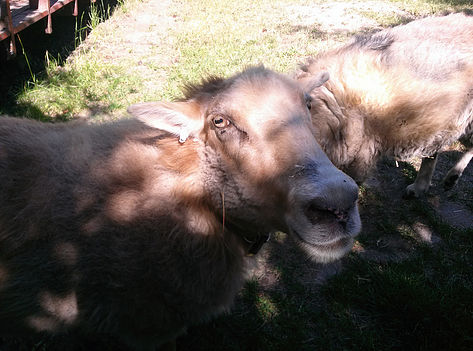
So the Trio will no longer be yard sheep...oh, the disappointed little faces...but doing what is best for the livestock is the right thing to do. Yes, I said it...the livestock (a second heavy sigh emits from deep within).
3. The Importance of Minerals
Sheep, like humans, need vitamins and minerals, and what they can't get from food, they need to get from their mineral supplements. Icelandics are a bit different from other breeds in that they need a lot more copper in their diet. Many breeds of sheep will die from copper poisoning, but Icelandics need it, so when I brought them home from Lee's, I fed them the same mineral supplement with added copper that they always got from her. At first, I mixed their salt, minerals, and kelp (Icelandics also need kelp) all together in their feeders, and they ate it - at least, the levels were going down, and we had to refill it occasionally. So at least one of them was eating it, and hopefully, all of them were getting some. But then I was told by somebody that everything should be separated out - the salt in one feeder, the minerals in another, and the kelp in a third. So I did that. That's when the levels stopped dropping, except for the salt. But to be honest, I just didn't really notice it that much. There was so much to pay attention to and figure out over the course of our first winter with sheep that I just didn't monitor the supplement feeders like I should have. Only recently did I figure out that they just aren't eating their minerals - and only recently did I discover that this oddball change in Black Velvet's fleece color is due to copper deficiency:
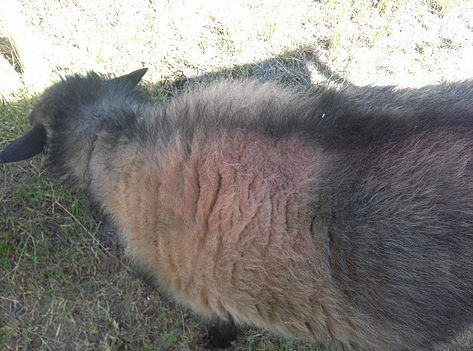
See those beigey-brownish patches on either side of the dorsal stripe down her back? Yup...copper deficiency. As with Mikey's injury, I got a sick feeling inside - how could I let this happen? How could I not notice they weren't eating their minerals? WHY did I change what was working (salt/minerals/kelp mixed together)??? Because now I can mix until the cows come home, but they want nothing to do with their old mineral mix. I've also tried some new minerals that an Icelandic shepherd in Oregon gave me this past weekend - nope. So I've done two things that I am praying will help turn this around - first, I've placed an order for Copasure, which is a copper capsule for sheep and goats. I can open one of these up, pour the powder into molasses, mix it up really well, spread it on a piece of bread, and before she knows it, Black Velvet will have downed a dose of copper that should get her levels back up to normal. I need to consider whether or not to give them to the other two - Panda Bear is quite a bit smaller than her sister, so I hesitate giving her too much copper. I want to do some comparisons between her coloring now and this time last year. And I think Mikey would be fine having a dose, but I am unsure whether or not he needs it, so I'll do some more research before giving one to him. The second thing I'm doing, and which helped to make me feel like I haven't totally flunked as a shepherd, is adding a little bit of sweet feed on top of the minerals. I tried this for the first time this morning, and...drum roll, please...IT WORKED! They couldn't avoid the minerals - they were so busy gobbling up the sweet feed, they were also gobbling up the minerals!
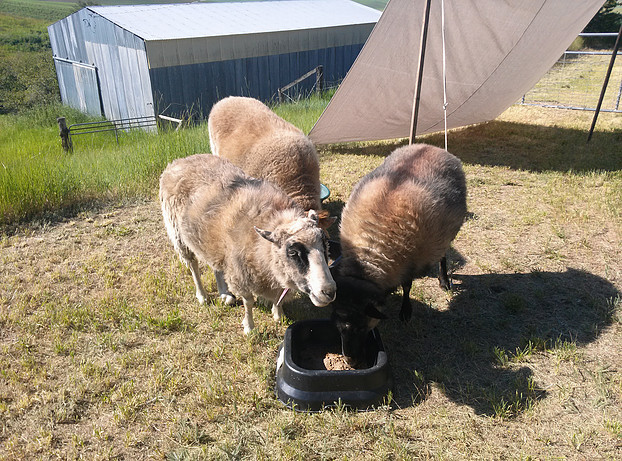

I can't begin to tell you how much this small victory meant to me this morning! Just knowing that I figured something out to help them be healthier made an enormous difference in my self-confidence. I want to do right by them - they give me wool, of course, but they also give us so much joy, and I want to make sure that we're giving back to them as well.
So every morning, they will be taken out to the pasture you see above...there is a lovely new sun shade, courtesy of my talented husband who rigged it up for the sheepies...and every morning, they will receive a little bit of sweet feed with their minerals. When this pasture is done, they will be rotated down into the next pasture, and by that time, there should be a 4th sheep in the mix...DAISY! Despite my worries...my insecurities...I know I can learn to do this better, and I still plan to grow my wee flock into a slightly larger wee flock!
Thank you, as always, for reading! I will leave you with my view this morning, as I stood at the bottom of the pasture and watched them graze...my sweet woolly (livestock) babies!
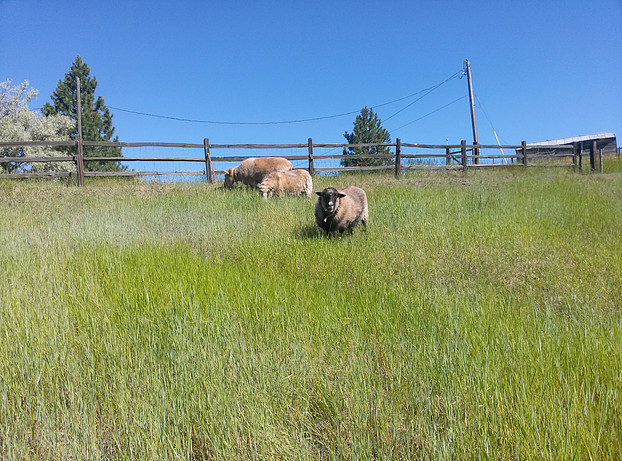
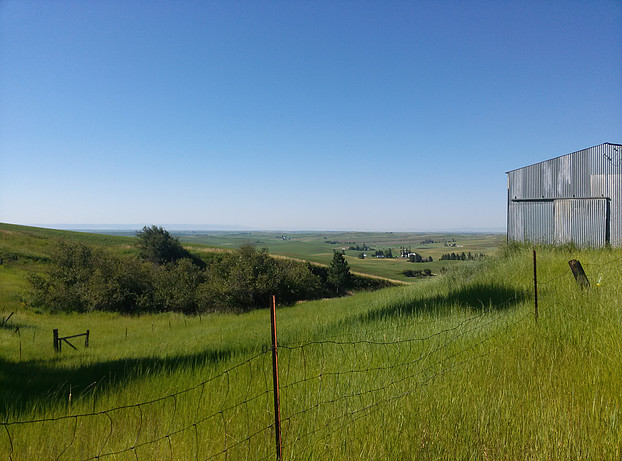
Postscript (6/15/17) - There is so much wrong with this blog post, which I recognize now. But then, hindsight is always 20/20. The biggest mistake I made was listening to one person about the Copasure and Black Velvet's coloring being due to copper deficiency. I should have talked to Lee...I should have contacted the WSU Veterinary Hospital for advice before administering something as potentially lethal as copper. I am grateful that I didn't lose a sheep because of the copper, but part of me will always think it is an odd coincidence that Mikey died so soon after the copper debacle. Despite what the necropsy results said, I can't help but feel responsible. So please...if you are a new-to-sheep shepherd, take this post with an enormous grain of salt. Know your soil - know your breed - do research! And if you have any questions at all, please let me know - if I don't have the answers, I will help you find them!




Comments
Oliverleo78613
Setting up a survey shows that the business values your feedback and ideas for improving their offerings. Additionally, one more advantage that this survey offers to participants is the survey prize.
[url=https://talktostopandshopo.online/]TalkToStopAndShop.com[/url]
Oliverleo78613
Setting up a survey shows that the business values your feedback and ideas for improving their offerings. Additionally, one more advantage that this survey offers to participants is the survey prize.
Anonymous
Employees of Northside Hospital can access their benefits and personal data online through the protected myNorthsideHR Employee Portal. Maintaining personnel data, viewing payroll information, creating new hire packs for recently hired staff, and more will all be within the HR department's capabilities.
mynorthsidehr
Anonymous
Excellent information may be found on this blog.
gta portal walmart
HyVee Huddle
Employees or other members of the Hyvee Huddle Login Company can utilise the internet portal Hy-Vee Connect. Using the Hyvee Connect login process, a newly hired member or employee can log in to Hyvee Huddle. By signing into the site, you can access benefits as an employee.
Sourav Tripathi
Devi Palace Hotel and Resort in Udaipur is the perfect choice for those seeking the best resort in Udaipur. Ideal for weddings, this luxury hotel near Annanta Resort offers stunning venues and top-notch service. If you're looking for a hotel in Udaipur that blends elegance and tradition, Devi Palace is the one!
Best Resort in udaipur
https://hoteldevipalace.com/
Ingles Weekly Ad
This week's Ingles Weekly Ad and next week's Ingles Ad! To view every page of the Ingles weekly ad circular, use the left and right arrow keys.
Ingles Weekly Ad
Ingles Weekly Ad
This week's Ingles Weekly Ad and next week's Ingles Ad! To view every page of the Ingles weekly ad circular, use the left and right arrow keys.
Prepare your coupons for the early Ingles weekly ad preview and plan your shopping trip in advance. Make sure you are seeing all of the latest Ingles weekly promotions by returning frequently.
Ingles Weekly Ad
GMGlobalConnect
The purpose of GMGlobalConnect is to offer a one-stop shop solution to dealers worldwide. With its headquarters in Detroit, General Motors is the biggest automaker in the world. Its main activities include designing, producing, marketing, selling, and maintaining American automobiles and auto parts.
GMGlobalConnect
LTD Commoditie
This blog is fantastic, and the content is first-rate.
: - LTD Commoditie
food lion weekly ad
Check out this week's complete ✳️ Food Lion Weekly Ad and next week's Food Lion Ad! Go read the Food Lion Weekly Circular from cover to cover. Prepare your coupons for the early Food Lion deals and schedule your shopping trip in advance!
food lion weekly ad
aldi ad next week
Weekly Ad for Aldi! If you shop at Aldi, visit this page every week to see the current weekly ad or use the ✳️ Aldi ad preview to see what forthcoming sales are coming up.
Aldi Weekly Ad
10 years dress for boys
Shop for the trendy collection of wedding/party 10 year boy dress online at best prices. MiniStitch offers a wide range of baby boy birthday dress10 year boy dress
Roy
I love how you break everything down so clearly. Thanks for making this topic easy to understand!
Full Face Laser Hair Removal
aldi ad next week
With millions of customers each month, Aldi Weekly Ad is a quickly growing supermarket business in the United States. ALDI is rapidly growing into one of the biggest grocery stores in the United States, with about 2,000 locations spread across 36 states.
Aldi's weekly advertisements have established a reputation for providing high-quality products at reasonable costs. Get the most recent information about the Aldi weekly ad here.
Aldi Ad
OKDHSLive
For winter heating assistance, a portion of OKDHS's public assistance beneficiaries already have pre-approval and do not need to submit an application. It has been communicated to these households that they're eligible for winter heating assistance. OKDHS assistance recipients who were qualified for the Winter Heating open enrollment period but whose residences did not meet the requirements for preauthorized selection received a letter. - OKDHSLive
winn dixie ad for next week
Check out the complete ✳️ Winn Dixie Sale Ad for this week and the Winn Dixie Ad Preview for next week! To view every page of the Winn Dixie Weekly Flyer, use the left and right arrow keys. We appreciate Sam alerting us to the early advertisement!
Prepare your coupons for the early Winn Dixie weekly circular and plan your shopping trip in advance! Make sure you are viewing all of the latest Winn Dixie weekly discounts by returning frequently.
winn dixie weekly ad
food lion weekly ad
Check out this week's complete ✳️ Food Lion Weekly Ad and next week's Food Lion Ad! Go read the Food Lion Weekly Circular from cover to cover. Prepare your coupons for the early Food Lion deals and schedule your shopping trip in advance!
This week's Food Lion sales ad is really simple to look at. To make it simple to determine if the item you're looking for at the Food Lion grocery shop is on sale or not, the sales are divided into different categories.
food lion weekly ad
Aldi Weekly Ad Preview
Many of the items in the Aldi ad are on sale even without coupons, however we are unable to combine these in-store discounts with coupons!
visit:- Aldi Weekly Ad Preview
Jewel Weekly ad Preview
Check out this week's complete Jewel Osco Weekly Ad and next week's ✳️ Jewel Osco Ad! Go through the Jewel Osco weekly ad circular from cover to cover.
For the early Jewel Osco weekly ad preview, which includes certain Jewel Osco weekly ad bogo discounts, prepare your coupons! Make sure you are viewing all of the latest Jewel Osco weekly discounts by returning frequently.
Jewel-Osco Weekly Ad
Jewel-Osco Weekly Ad
See the full Jewel Osco Weekly Ad this week and the ✳️ Jewel Osco Ad the following week! Examine every page of the Jewel Osco weekly ad circular.
Get your coupons ready for the early Jewel Osco weekly ad preview, which features some Jewel Osco weekly ad bogo deals! Return often to ensure you are seeing all of the most recent Jewel Osco weekly discounts.
Jewel Ad
winn dixie ad for next week
Check out the complete ✳️ Winn Dixie Sale Ad for this week and the Winn Dixie Ad Preview for next week! To view every page of the Winn Dixie Weekly Flyer, use the left and right arrow keys. We appreciate Sam alerting us to the early advertisement!
Prepare your coupons for the early Winn Dixie weekly circular and plan your shopping trip in advance! Make sure you are viewing all of the latest Winn Dixie weekly discounts by returning frequently.
winn dixie weekly ad
Jewel-Osco Weekly Ad
Check out this week's complete Jewel Osco Weekly Ad and next week's ✳️ Jewel Osco Ad! Go through the Jewel Osco weekly ad circular, page by page.
The early Jewel Osco weekly ad preview includes some Jewel Osco weekly ad bogo offers, so have your coupons ready! To be sure you are taking advantage of the most recent Jewel Osco weekly offers, return frequently.
Jewel Ad
Daisy Mart
đồ chơi cho trẻ sơ sinh từ 0 đến 6 tháng tuổi, quà tặng cho trẻ sơ sinh
Ralphs Weekly Ad
Check out this week's and next week's complete Ralphs Weekly Ad! To view every page of the Ralphs weekly ad circular, use the left and right arrow keys.
Prepare your coupons for the Ralphs weekly ad preview, which includes some bogo discounts!
Looking through the Ralphs weekly flyer is a breeze. The Ralphs sales this week are broken down into sections to make it simple to determine whether the item you're looking for is on sale or not.
Looking through the Ralphs ad for next week and finding the greatest discounts will save you a lot of money! Don't pass up the fantastic discounts in the next Ralphs weekly ad!
Ralphs Weekly Ad
Winn Dixie ad
Check out the complete ✳️ Winn Dixie Sale Ad for this week and the Winn Dixie Ad Preview for next week! To view every page of the Winn Dixie Weekly Flyer, use the left and right arrow keys. We appreciate Sam alerting us to the early advertisement!
Prepare your coupons for the early Winn Dixie weekly circular and plan your shopping trip in advance! Make sure you are viewing all of the latest Winn Dixie weekly discounts by returning frequently.
Winn Dixie Weekly ad
ingles weekly ad
Check out this week's entire Ingles Weekly Ad and next week's Ingles Ad! To view every page of the Ingles weekly ad circular, use the left and right arrow keys.
Prepare your coupons for the early Ingles weekly ad preview and plan your shopping trip in advance. Make sure you are seeing all of the latest Ingles weekly promotions by returning frequently.
Looking through the Ingles weekly flyer is a breeze. This week's Ingles sales are broken down into categories to make it simple to determine if the item you're looking for is on sale or not. regardless of the goods you choose to purchase.
ingles weekly ad
Raghavsinghania0897
Dr. Stuti Khare Shukla’s work in non-surgical hair growth treatments is truly revolutionary. I was impressed by the detailed insights on FDA-approved Hair Growth Booster® therapy and the success stories shared. Her achievements like being named the 'Youngest Dermatologist of India' and receiving the 'ET Inspiring Woman of India' award speak volumes about her expertise. Highly recommend checking out her official site for anyone looking for advanced dermatological solutions.
https://drstutikhareshukla.com/
Pick N Save Weekly Ad
Check out this week's Pick N Save Weekly Ad and next week's Pick N Save Ad in full! To view every page of the Pick N Save weekly ad circular, use the left and right arrow keys. Prepare your coupons for the early Pick N Save weekly ad preview and plan your shopping trip in advance!
Looking through the Pick N Save weekly flier is a breeze. This week's Pick N Save sales are broken down into categories to make it simple to determine if the item you're looking for is on sale or not. Check out the Pick N Save advertisement for next week, regardless of the goods you wish to purchase.
Pick N Save Weekly Ad
Walgreens Weekly Ad
Walgreens Weekly Ad - This week's Walgreens Weekly Ad and next week's ✳️ Walgreens Ad! Go through the entire Walgreens advertisement scan. Prepare for the upcoming Walgreens sales advertisement!
Winn Dixie ad
Check out the complete ✳️ Winn Dixie Sale Ad for this week and the Winn Dixie Ad Preview for next week! To view every page of the Winn Dixie Weekly Flyer, use the left and right arrow keys. We appreciate Sam alerting us to the early advertisement!
Prepare your coupons for the early Winn Dixie weekly circular and plan your shopping trip in advance! Make sure you are viewing all of the latest Winn Dixie weekly discounts by returning frequently.
Winn Dixie ad
Publix Weekly Ad
Check out this week's complete ✳️ Publix Weekly Ad and next week's Publix Ad preview! Go through the Publix weekly ad circular from cover to cover.
Depending on your store, the new ad will run for one week starting on either Wednesday or Thursday. Make sure to check your store's schedule. Get your coupons ready for the early ✳️ Publix weekly ad preview, which includes certain Publix weekly ad bogo discounts, and plan your shopping trip in advance!
Perusing the Publix weekly flier is a breeze. This week's Publix sales are broken down into categories to make it simple to determine if the item you're looking for is on sale or not.
Publix Ad
Rouses Weekly ad
See this week's complete ✳️ Rouses Weekly Ad and the Rouses Ad the following week! To view every page of the Rouses weekly ad circular, use the left and right arrow keys. Prepare your coupons for the early Rouses weekly ad preview and plan your shopping trip in advance!
Make sure you are viewing all of the latest Rouses weekly deals by returning frequently.
Looking through the Rouses weekly flier is a breeze. To make it simple to determine if the product you're looking for is on sale or not, the Rouses sales this week are divided into categories. Be sure to review next week's routines regardless of the product you wish to purchase.
Rouses Weekly ad
Walgreens Weekly Ad
See this week's complete ✳️ Walgreens Weekly Ad and next week's ✳️ Walgreens Ad! Go through the entire Walgreens advertisement scan. Prepare for the upcoming Walgreens sales advertisement!
Looking through the Walgreens Circular is a breeze. To make it simple to determine whether the product you're looking for is on sale or not, Walgreens' sales are broken down into categories. To avoid going over budget, always check the Walgreens weekly circular to see if the product you want to buy is on sale.
Walgreens Weekly Ad Preview
Dollar General Weekly Ad
Check out this week's complete ✳️ Dollar General Weekly Ad and next week's ✳️ Dollar General Ad! Go through the entire Dollar General weekly sales advertisement. Prepare your coupons for the upcoming weekly ad from Dollar General!
Browse the Dollar General ad preview and find the best offers to save a lot of money! Don't pass up the fantastic deals in the weekly flyer from Dollar General!
It's pretty simple to look through the Dollar General weekly sales advertisement. To make it simple to determine if the item you're looking for is on sale or not, Dollar General's sales are divided into categories.
Dollar General Ad
Ministitch
Explore the latest collection of girls dresses for wedding , ideal for parties and weddings. Shop beautiful Girls gown designs to make her special day . girls dresses for wedding
Pick N Save Weekly Ad
Check out this week's Pick N Save Weekly Ad and next week's Pick N Save Ad in full! To view every page of the Pick N Save weekly ad circular, use the left and right arrow keys. Prepare your coupons for the early Pick N Save weekly ad preview and plan your shopping trip in advance!
Looking through the Pick N Save weekly flier is a breeze. This week's Pick N Save sales are broken down into categories to make it simple to determine if the item you're looking for is on sale or not. regardless of the goods you choose to purchase.
Pick N Save Ad
Harris Teeter Weekly Ad
Check out this week's complete Harris Teeter Weekly Ad and the Harris Teeter Ad for next week! To view every page of the Harris Teeter weekly ad circular, use the left and right arrow keys. Prepare your coupons for the early Harris Teeter weekly ad preview and plan your shopping trip in advance!
Make sure you are viewing all of the latest Harris Teeter weekly discounts by returning frequently.
It's quite simple to look through the Harris Teeter weekly flier. The Harris Teeter sales this week are broken down into sections to make it simple to determine if the item you're looking for is on sale or not.
Harris Teeter Ad
Rouses Weekly ad
See this week's complete ✳️ Rouses Weekly Ad and the Rouses Ad the following week! To view every page of the Rouses weekly ad circular, use the left and right arrow keys. Prepare your coupons for the early Rouses weekly ad preview and plan your shopping trip in advance!
Make sure you are viewing all of the latest Rouses weekly deals by returning frequently.
Looking through the Rouses weekly flier is a breeze. To make it simple to determine if the product you're looking for is on sale or not, the Rouses sales this week are divided into categories. Be sure to review next week's routines regardless of the product you wish to purchase.
Rouses Weekly ad Preview
Stop And Shop Weekly Ad
Check out the Stop and Shop flyer for next week, as well as the Stop and Shop circular! Examine every page of the Stop & Shop Weekly Ad.
To plan your shopping trip in advance and prepare your coupons for the new sales at Stop & Shop grocery shops, check out the early Stop & Shop weekly circular! - Stop And Shop Weekly Ad
Post new comment